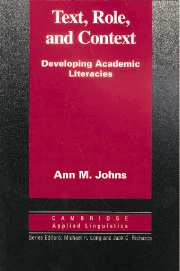Book contents
- Frontmatter
- Contents
- Series editors' preface
- Preface
- Acknowledgments
- 1 Literacy and pedagogy: Three views
- 2 Genre knowledge and socioliteracies: What readers and writers may share
- 3 Genre and social forces: “Homely” and academic texts
- 4 Discourse communities and communities of practice: Membership, conflict, and diversity
- 5 Special roles: Literacy practitioners as campus mediators and researchers
- 6 Students as researchers: Investigating texts, processes, and contexts
- 7 The socioliterate classroom: Basic tenets and goals
- 8 Putting tenets and goals into practice: Using portfolios in literacy classrooms
- 9 Conclusion
- References
- Index
4 - Discourse communities and communities of practice: Membership, conflict, and diversity
Published online by Cambridge University Press: 05 October 2012
- Frontmatter
- Contents
- Series editors' preface
- Preface
- Acknowledgments
- 1 Literacy and pedagogy: Three views
- 2 Genre knowledge and socioliteracies: What readers and writers may share
- 3 Genre and social forces: “Homely” and academic texts
- 4 Discourse communities and communities of practice: Membership, conflict, and diversity
- 5 Special roles: Literacy practitioners as campus mediators and researchers
- 6 Students as researchers: Investigating texts, processes, and contexts
- 7 The socioliterate classroom: Basic tenets and goals
- 8 Putting tenets and goals into practice: Using portfolios in literacy classrooms
- 9 Conclusion
- References
- Index
Summary
If there is one thing that most of [the discourse community definitions] have in common, it is an idea of language [and genres] as a basis for sharing and holding in common: shared expectations, shared participation, commonly (or communicably) held ways of expressing. Like audience, discourse community entails assumptions about conformity and convention (Rafoth, 1990, p. 140).
What is needed for descriptive adequacy may not be so much a search for the conventions of language use in a particular group, but a search for the varieties of language use that work both with and against conformity, and accurately reflect the interplay of identity and power relationships (Rafoth, 1990, p. 144).
A second important concept in the discussion of socioliteracies is discourse community. Because this term is abstract, complex, and contested, I will approach it by attempting to answer a few of the questions that are raised in the literature, those that seem most appropriate to teaching and learning in academic contexts.
Why do individuals join social and professional communities? What appear to be the relationships between communities and their genres?
Are there levels of community? In particular, can we hypothesize a “general academic community” or language?
What are some of the forces that make communities complex and varied? What forces work against “shared participation and shared ways of expressing?” (Rafoth, 1990, p. 140).
- Type
- Chapter
- Information
- Text, Role and ContextDeveloping Academic Literacies, pp. 51 - 70Publisher: Cambridge University PressPrint publication year: 1997
- 5
- Cited by

